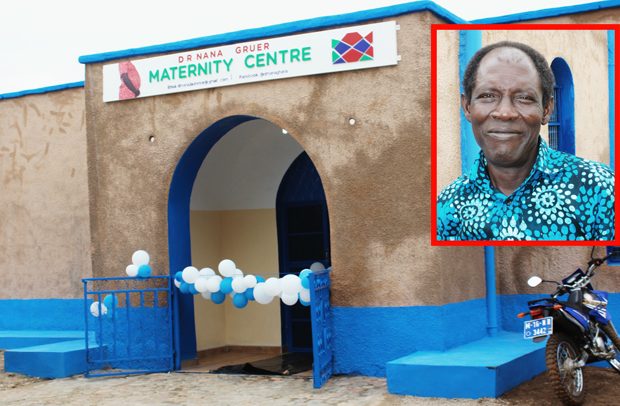Front side of a Nubian Vault building. INSET: Daniel Bangrey
As government looks for cheaper and sustainable ways towards addressing the increasing national housing deficit, a Nubian vault housing architecture entrepreneur, Daniel Bangrey, has called on government to adopt this alternative building approach and create a scheme to support Ghanaians to put up cheaper but long-lasting houses.
According to Mr Bangrey, the Nubian houses are built with local materials made of clay/mud, gravels and stones, with very little cement and wood or metals for finishing purpose.
“The arrangement of the earth bricks and the creation of the vaults at the top makes it strong and long lasting. These buildings can last for centuries and if there were earth tremours in the north, these buildings would be able to withstand them,” he revealed.
He spoke in an interview with the DAILY GUIDE during the official handing over of a maternity centre built with the Nubian vault architecture for the Balungu Health Centre in the Talensi District in the Upper East Region.
Mr Bangrey’s non-governmental organisation, Peal Deng, partnered with Dr Nana Foundation to build the Dr Nana Gruer Maternity Centre in memory of Dr Nana Gruer and in response to the request of the people of Balungu.
The National Coordinator of the Nubian Vault Association-Ghana, Thomas Dietrich, pointed out that the Nubian vault architecture has so far proven to be the best style of building for the three regions in Northern Ghana- Upper East, Upper West and the Northern Region.
According to Mr Dietrich, the Nubian vault buildings are able stand the strong wind that rips off many roofs and push down buildings in these regions in the north during the rainy season. The building also provides a cool room temperature even when the outside temperature is hot during the dry season.
He said the Nubian Vault Association for a period of 20 years has constructed a total of 3,000 Nubian vault buildings for families and institutions in five countries- Burkina-Faso, Mali, Senegal, Benin and Ghana.
“In Ghana, we are working in the three regions in the north due to the long dry season period and by the time the rains start, we would have finished any project we are handling. We use mud and gravels and so we make sure the work is not delayed beyond the dry season. In Benin, too, we work in the northern part, but in Burkina-Faso, Mali and Senegal, we work in any part of the country because of their weather pattern,” Mr Dietrich stated.
“With this style of building, local farmers can work on a project and complete in the dry season and quickly switch to farming during the rainy season, which follows immediately. If government accepts this architecture as the way to build health facilities in the northern regions, it will be helping to keep the local people in a productive venture throughout the year. They will work as masons or labourers during the dry season and then, farm during the rainy season,” Mr Dietrich explained.
The Nubian vault is an ancestral construction technique originating from Upper Egypt, using only raw earth bricks and earth mortar. It represents a sustainable and affordable alternative to the roofing sheets and cement block buildings that are widespread in West Africa in recent time.
From Ebo Bruce-Quansah, Balungu

